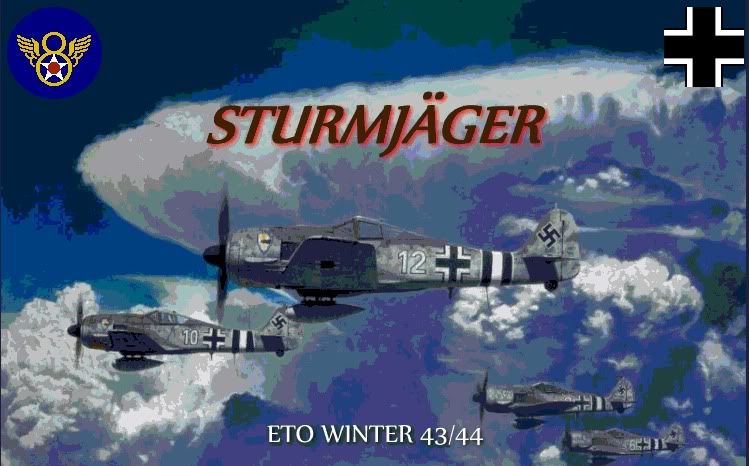
STURMJAEGER!
This week we are running Shifty's thoughtful setup, recreating the
period November, 1943 - March, 1944 (see Shifty's
write-up below). For good or ill we have modified
the setup to allow for vehicle combat and base
capture. Thus, instead of the BoB map, we are
using USRanger's excellent Twin River map.
USAAF (Bishops)
P-38J
P-47D11
P-47D25
P-51B
B-17
B-24
C-47
GVs
Jeep
The Ms
M4A3 (75mm)
Luftwaffe (Knights)
FW-190A8
BF-109G6
BF-109G14
BF-110G
Ju-88
C-47
GVs
Jeep
Panzer IV
SdKfz 251
Ostwind
Wirbelwind
ARENA SETTINGS:
Bombsight: AvA standard (try it, it's fun)
Killshooter: on
Visibility: 14.0 miles
Fuel burn rate: 1.0
Ack settings: .25
Base capture: 10 (map room .0015)
Radar (1943):
Sector 316,800
Tower 132,000
Icons: Enemy off, Friendly short
THE HISTORY:
On 8th November 1943 Generalleutnant Galland
sent a signal to his unit commanders. It read:
"German fighters have been unable to obtain
decisive success in the defence against American
four-engine formations. Even the introduction of
new weaponry has not appreciably changed the situation.
The main reason for this is the failure of formation
leaders to lead up whole formations for attack at
the closest possible range. Reichmarschall Goering
has therefore ordered the establishment of a Sturmstaffel
whose task will be to break up allied formations by
means of an all out attack with more heavily armed
fighters in close formation and at the closest range.
Such attacks that are undertaken are to be pressed
home to the very heart of the allied formation whatever
happens and without regard to losses until the formation
is annihilated."
And so the concept of Sturmstaffel 1 was born.
The theory of its operational tactics had been developed
in the summer of 1943 by Major Hans-Gunter von Koratzki.
He had concluded, through studying gun camera footage
and talking to experienced pilots that concentrated
formation attacks from the rear of the American bomber
combat boxes was the thing to do, even though frontal
attacks were being used with some success at the time.
All aircrew of Sturmstaffel 1 were volunteers. Some idea
of their task can be gleaned from their code of operations:
"Without exception, the enemy will be approached in close
formation. Losses during the approach will be immediately
made up by closing up with the attack leader. The enemy
will be shot down at the closest range. If that becomes
impossible, ramming will be the only alternative. The Sturm
pilot will remain with the damaged bomber until the aircraft
impacts."
This was very dangerous work. The concentrated .50 caliber
defensive fire from the American formations was well known
to the German pilots, so extra armour was fitted to their
FW-190s in the form of 50mm glass front windscreen, 30mm
glass sides on the canopy, 5mm steel on the fuselage around
the cockpit and seat, and 12mm behind the head. As 1943
gave way to 1944 Sturmstaffel 1 was joined by Sturm Gruppen
from JG-3 and JG-300. These gruppen along with BF-110Gs
threw their heavily armed Sturmbockes against 8th AF Bomber
formations. The heavily armored FW-190A8s were vulnerable
to the P-38 and P-47 escorts of the 8th AF, not to mention
the new P-51 Mustang that was beginning to make it's presence
felt in the Sky's above Germany, Holland and France. To counter
this, Western front Jagdgeschwaders pressed BF-109G6s and
G14s into escort service, attempting to protect the Sturmbockes
and 110s from 8th AF fighters. Hunters and hunted from both
sides collided in huge battle to once and for all establish
air superiority over Western Europe.